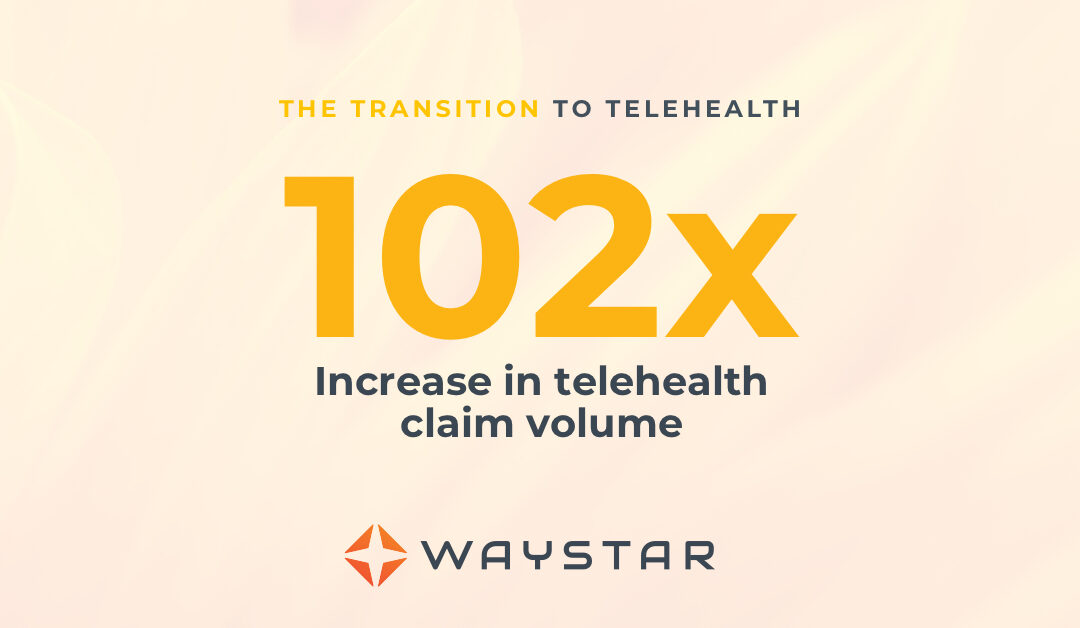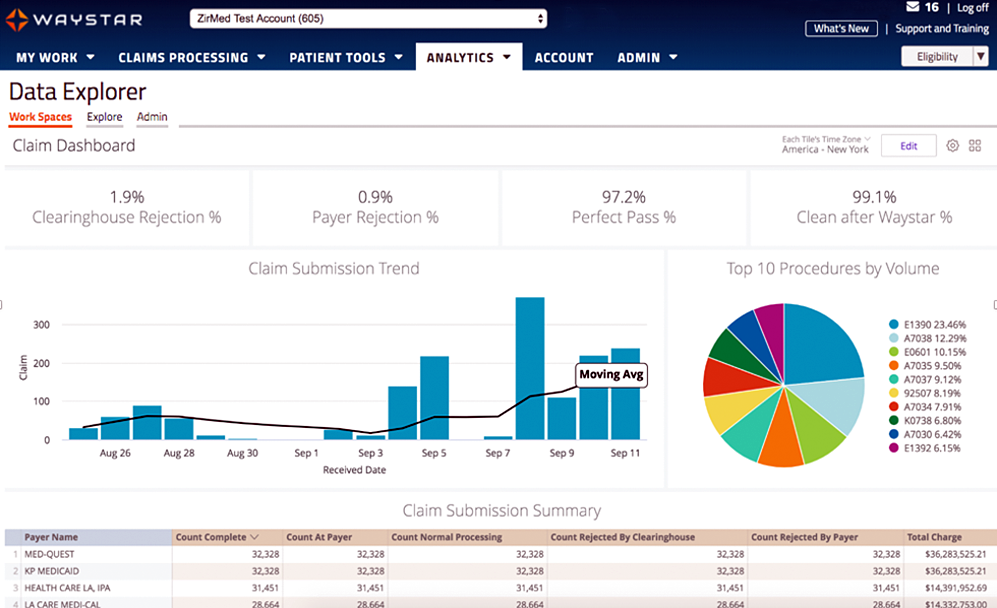
Dec 14, 2020 | AMBA National Conference, Claims, Cloud Security, Denied Claims, EZClaim Cloud, EZClaim Premier, Medical Billing Customer Service, Medical Billing Software Blog
Deborah Rieser founded Spectrum Medical Billing Services in Anchorage, Alaska 15 years ago to make extra money to help with paying the family’s bills. Today, she owns a thriving medical billing service with a team of “twelve lovely ladies”—as she likes to refer to them—that services clients nationwide. Rieser originally selected EZClaim’s medical billing software platform—because of its pricing structure—to use for her medical billing service.
Over the years, since her original purchase, she has upgraded to each new EZClaim version, which adding new features and efficiencies. Recently, she has made the transition to EZClaim Cloud, and continues to use it exclusively today.
With team members nationwide, Rieser prides herself on training her billers on properly classifying billing for medical offices so that there are minimal insurance denials. She is very particular about this since one of the reasons Deborah began billing was the insurance qualification struggles she had for her daughter with Autism. So, accurate billing is ‘personal’.
Recently, we found time to interview Rieser about her start in the industry, the ups and downs of being a business owner, and what hard-fought expertise she has gained that might help others considering to start their own medical billing service.
EZCLAIM: When did you get into the medical billing industry and why?
RIESER: “I always had an entrepreneurial spirit, and I had an orchid business out of our house. Then my daughter, who was born with Autism, started working with an Occupational Therapist (OT), and they came to me to help with billing. I thought about it, and after a few weeks, I took it on. That was back in 2005.
“At that time, my daughter had over 75 volunteers and therapists in the community work with her from age three to age five, and had 50-60 hours a week of therapy. Today, she is a sophomore in university, has a boyfriend, is driving her car, and is thriving. From all of that, I have always felt the need to give back to the community for all their help. So, I used my business to take on other Pediatric, Occupational Therapy, Physical Therapy, and Speech Therapy clients, as well as, using my experience to help patients take care of their billing needs and get their bills paid by insurance.”
EZCLAIM: What are you passionate about when it comes to billing?
RIESER: “For me, the biggest thing that I am passionate about is seeing my clients [medical offices] getting paid from insurance claims. I also enjoy helping patients get properly classified during medical visits, so claims are accepted. I have learned a lot from the mistakes and errors that have led to denied claims. From my experience, I can help medical practices observe their approach to patients’ needs so that services qualify when billing insurance companies. Being able to offer that to my clients is very satisfying.”
EZCLAIM: What are some of the challenges you have had to overcome?
RIESER: “Originally, we grew word-of-mouth. I didn’t even want a website at first, but now I do have one. Going from one client to 65 is challenging because as your clients grow, your staff grows. Recently, I lost a client. You then have to decide what you’re going to do with your staff. The hardest part is that, for a business owner, your business consistently goes up and down. That fluctuation can be stressful. For me, I deal with that by going outdoors. My husband and I will go for a walk in nature and that will help relieve my stress.”
EZCLAIM: What advice would you offer others in the billing industry that have similar experiences?
RIESER: “If you’re starting your own business, make sure it’s one you love. Know that there will always be highs and lows. Also, be sure to price yourself accordingly. You can’t go too high or people will look elsewhere.
“I do want to step back and highlight that some of my billing practices only do 2-3 claims a week, and that’s why I love EZClaim. The price of the software. When I was growing, I was working on EZClaim “Advance,” which is being retired. So, when I started looking around at other software providers, they were billed on a ‘per provider cost.’ Fortunately, EZClaim “Cloud” billed based on the number of concurrent users, which worked for me.”
EZCLAIM: How has your relationship with AMBA (American Medical Billing Association) benefitted you?
RIESER: “I just joined last year in 2019, thanks to EZClaim and Dan Loch’s referral. I love that group. I joined their Facebook group because they have very useful information for us billers. I recommended that my team members join as well. They are good at supporting US-based companies and put the focus on supporting the group.”
EZCLAIM: What would you tell people who are wondering if EZClaim Cloud is right for them?
RIESER: “The transition to EZClaim Cloud was easy. I was worried about the providers and the tax ID’s, but it all was very smooth. I would add that customer support was very helpful. As daunting as moving things over felt, it was very smooth. I attribute that to the planning and support.”
EZCLAIM: What would you say would be a strength of someone who is good at billing and coding?
RIESER: “It is important to be a very good communicator, professional, out-going, and enjoy what you do. One must be able to communicate with providers over denials, success, celebrations, and always keep talking with the staff and the providers. Also, always try to put yourself in the patients’ shoes by offering patience and compassion. Lots of times patients don’t understand their benefits and why they are denied. So, try to explain in layman’s terms. They understand better and appreciate that. It ends up being a good connection with the patient, and benefits you as the biller, too.”
EZCLAIM: Final thoughts?
RIESER: “I am grateful to EZClaim for their services. As a business owner, you have to monitor expenses and things can add up fast. So, I am thankful for EZClaim Cloud and its pricing structure. That has helped Spectrum Medical Billing Services to grow and thrive.”
[ The above answers were paraphrased as closely as possible to the original answers given by Deborah Rieser on November 25, 2020 ].
ABOUT EZCLAIM:
EZClaim is a medical billing and scheduling software company that provides a best-in-class product, with correspondingly exceptional service and support. Combined, they help improve medical billing revenues. To learn more, visit EZClaim’s website, e-mail them, or call a representative today at 877.650.0904.

Nov 10, 2020 | Alpha II, BillFlash, Claims, collections, Denied Claims, EZClaim Premier, HIPAA, Medical Billing Software Blog, Revenue, Support and Training
It IS POSSIBLE to improve medical billing revenues, and here are a few ways to do just that.
Healthcare practitioners, whether established or just starting out, have many overwhelming tasks: Managing a practice; Seeing patients; Working to staying up-to-date on administrative tasks; The whole host of compliance at the federal, state, and local level; and Overseeing the billing.
One of these that can lead to loss of revenue is not properly managing the medical billing, which can also lead to HIPAA fines and rejected claims. However, there is a solution: a medical billing system that balances the budget and optimizes revenues of medical practice.
EZClaim, an expert in the medical billing software market since 1997, provides a solution that improves the efficiency of an office’s billing process in many ways. The following are the primary reasons.
Reduce Coding Errors
Medical procedures become codes, codes become claims, and claims become revenue. Any error in this process can make claims to be denied, your workload can be increased, and revenue can be lost. To help in avoiding errors, it is essential to use billing software that offers the easiest implementation and access to descriptive diagnosis and treatment codes. EZClaim’s medical billing solution offers ease-of-use in coding, billing, and strong partnerships with Clearinghouses which act as an additional ‘safety net’ for catching errors.
Administrative Support
Most medical practices are a small team of people tackling a wide range of tasks, so when one cannot understand the function of the billing software, accessing reliable support is very important. EZClaim prides itself on having dedicated support experts available, and that was how the company was established. Founder and President Al Nagy has said, since day one, “We are a support company that happens to sell medical billing software.”
Maintain Industry Compliance
It is important to recognize that industry compliance and a practice’s revenue go hand-in-hand. Filing and batching inaccurate and non-HIPAA compliant claims can often be traced back to an outdated healthcare revenue management system. Conquering these tasks requires a focus on multiple fronts: A properly trained billing team, clear office procedures, patient payment policies, and a reliable medical billing company. These are all ways to help buttress against non-compliance and rejected claims.
Streamline Workflow
Recently, a study was done that showed almost 80% of medical bills contain errors. These incorrect medical claims often end up as lost revenue originally, not to mention the additional cost of resubmissions and collections. One of the best ways to resolve this problem for your practice is to make use of both well-trained, experienced billers and coders, combined with a competent medical billing solution that aids in catching these errors. EZClaim software features a library of standard validation, the ability to add custom validation, and integrates with Alpha II for full claim scrubbing.
Follow up
Errors will and do occur, so establishing a system for follow-up on all denials will close the loop and protect against lost revenue. Being consistent with the follow-up process, and having a medical billing solution that tracks these things will help close that gap.
Collections
Finally, probably the most important aspect that optimizes a practice’s revenue is to get paid. Portals and payment collection systems definitely help with this, but having collections integrated into the medical billing system is, of course, the best. EZClaim has pain-free payment processing integrated into their solution, called EZClaimPay. It solves all the problems associated with payment processing: Bank deposits, reconciliation, statements, changing fees, and ‘finger-pointing’ when there is a problem. EZClaimPay’s robust platform will greatly increase a practice’s collections success, and improve their revenue.
———————————-
ABOUT EZCLAIM:
EZClaim is a medical billing and scheduling software company that provides a best-in-class product, with correspondingly exceptional service and support, and can help improve medical billing revenues. To learn more, visit their website, e-mail them at sales@ezclaim.com, or call a representative today at 877.650.0904.
[ Photo credit: Studioarz ]


Oct 12, 2020 | Medical Billing Software Blog, Partner, Revenue, Waystar
Today’s healthcare landscape faces truly unprecedented challenges, which means it’s more important to get the most out of your analytics to develop more informed, strategic decisions. There’s a deep well of data that each revenue cycle feeds into, which if properly analyzed, can help organizations operate at their most efficient and effective. Here are the four stages of data analytics workflows that are key to developing those actionable insights: A “Trigger,” or the point in your revenue cycle that sets up the call for deeper analysis; “Interpretation” of data to determine root causes and identify appropriate next steps; “Intervention” to improve specific metrics; and “Tracking” of said metrics to chart success in achieving desired outcomes.
So, let’s examine what a successful version of each stage looks like:
Trigger:
The trigger occurs when you notice something that needs further investigation. With the right analytics tool you can easily access all of your key performance indicators, financial goals and more, providing the visibility you need into your rev cycle. When something looks amiss or needs improving, you can drill down to the level that shows what’s really going on.
Interpretation:
Even a wealth of data amounts to nothing without an efficient way to process and communicate key takeaways. You’ll need to equip your team with access to concise reports, smart visualizations and relevant historical data in order to get them to the insights that drive action.
Intervention:
Now is the time to take action. Intervention is ultimately tied directly to your ability to drill down into the data underlying problematic areas of your revenue cycle and clearly communicate takeaways with your team. Success at this stage depends on designing a plan based on your best understanding of underlying issues and the most effective way to address them.
Tracking:
Your intervention plan is built on KPIs that naturally intertwine with the way you measure success across your revenue cycle. With proper implementation and tracking, running with the analytics cycle can become a simple addition to your everyday workflow. More than delivering on your initial goals, the true power of analytics is the ability to deliver repeat value on your initial investment.
Wrap Up
A strong analytics solution does more than deliver a more fully developed picture of your revenue cycle performance. It provides actionable business intelligence, cuts down on time between analysis and action, and lessens the strain on your IT department.
Waystar is a ‘partner’ of EZClaim, and provides analytics for a practice using their medical billing software. For more details about EZClaim’s products and services, visit their website: https://ezclaim.com/
To learn more about how Waystar can help you harness the power of your data, call their main office at 844-4WAYSTAR, or call sales at 844-6WAYSTAR.
[ Contributed by Waystar ]

Oct 12, 2020 | Electronic Billing, Features, Medical Billing Software Blog
EZClaim Launches EZClaimPay, a new feature in its medical billing software that makes credit card processing painless!
EZClaim, a company with the mission of elevating its clients to stay in front of the ever-changing landscape of medical billing, announced today the launch of its credit card processing feature and service called, EZClaimPay.
EZClaim released the product in August 2020 as a solution to the ever-changing landscape of payment reconciliation. It was cited by customers as a timely response to a ‘pain point’—credit card payment processing—another example of EZClaim’s devotion to their mission.
Dan Loch, VP of Marketing commented that “EZClaim’s goal continues to be making life easier for medical billers at practices and billing firms. EZClaimPay is just one more feature within our mission of living up to that goal.” This feature will help companies get in front of the changes in medical transparency that are coming soon.
EZClaimPay provides for consolidated reconciliation (Payment reports; Chargeback management; and Reconciliation reports) and a single point of contact for support (Hardware; Software; and Payments).
EZClaim has developed a robust payments platform—tightly integrated with their software and support—to make accepting credit cards for payment PAINLESS! EZClaimPay makes software and payments better together.
For more details about EZClaimPay, view this web page: https://ezclaim.com/ezclaimpay/
ABOUT EZCLAIM:
EZClaim is a medical billing and scheduling software company that provides best-in-class customer service and support. To learn more, e-mail them at sales@ezclaim.com or call a representative today at 877.650.0904.

Sep 10, 2020 | Electronic Billing, Medical Billing Software Blog, Partner
In the wake of the COVID-19 pandemic, Telehealth adoption has exploded, and there are six revenue cycle metrics to track.
Many patients are prohibited or reluctant to venture out for on-site care. The combination of relaxed regulations and expanded payment parity for appointments has made virtual meetings easier and more attractive for providers, who are turning to these technologies to stay engaged with patients—and maintain cashflow. Dr. Robert McLean, a former president of the American College of Physicians, recently said, “this crisis has forced us to change how we deliver health care more in 20 days than we had in 20 years.”
A new industry report predicts that the number of Telehealth visits in the US will surpass one billion by the end of the year, and speculates that nearly half of those visits will be related to COVID-19. At Waystar, we have been closely monitoring claim trends and are seeing this growth firsthand. In fact, the volume of Telehealth claims on the Waystar platform has grown by more than 100 times since mid-March. On two particular days in late April, they accounted for more than 15% of our total daily claim volume. Before COVID-19, they would have accounted for less than one percent!
For many providers, this shift will require new revenue cycle strategies to meet growing patient demand without overwhelming clinicians and administrative teams—or already strained operating budgets. It’s important to remember this is still very much an evolving care delivery model with the opportunity for errors on the part of both payers, providers, and administrative staff. For this reason, revenue cycle professionals should diligently monitor claims to ensure proper adjudication, identify learning opportunities, and uncover areas for operational improvement.
Below, we’ve listed six core Telehealth-related metrics you should regularly track to ensure billing accuracy, maximize payer reimbursement, and reduce claim rejections and denials. For more on how to best navigate the evolving telemedicine landscape, check out our resource hub here.
To report on Telehealth-related claims, you’ll first need to identify and isolate claims containing Telehealth procedure codes. See CMS’ Telehealth code list to identify the specific procedure codes and modifiers that apply to your organization.
Payer Analysis:
1. Payer Telehealth claim rejections by volume and/or billed amount
2. Payer Telehealth claim denials by volume and/or billed amount
If your Telehealth claims are being denied or rejected, do you know which specific payers are doing so at the highest rate? Drill down to discover the specific reason codes payers are attaching to rejections and denials so you can better understand payer-specific rules and avoid these oversights in the future. In some cases, you may identify trends that warrant a call to the payer to correct.
Provider Analysis:
3. Telehealth claim volume by the provider
Review this claim volume by individual provider. If you notice providers within your organization generating a much lower volume of Telehealth claims than peers, perhaps they could benefit from additional training on Telehealth technology and use cases.
Ensuring Billing Accuracy:
4. Telehealth claim rejections by biller/team
5. Telehealth claim denials by biller/team
Are certain billing personnel or teams producing higher denial or rejection rates than others? Keep a close eye on these trends and remember most of this is new for everyone. If some team members are seeing more rejections or denials than they should, it could be a great opportunity to hold training and collaborate on strategies for success.
Maximizing Reimbursement:
6. Telehealth claim volume by procedure code
Which Telehealth codes are you using? Each code reimburses at a different rate, so choosing the wrong ones could leave money on the table. Be sure to read up on CMS’ requirements (check out their fact sheet and code list) to ensure you’re choosing the appropriate code(s) on each Telehealth claim.
Waystar Analytics
You have all the data you need to drive informed decision making and improve financial performance—you just need the right analytics tool in your corner. Our new Waystar Analytics solution offers a pre-built Telehealth dashboard that can help you easily interpret, share all the metrics above, and track these revenue cycle metrics. Click here to learn more about Waystar Analytics and how it can deliver the insights you need during this time of transition.

[ By Waystar ]








